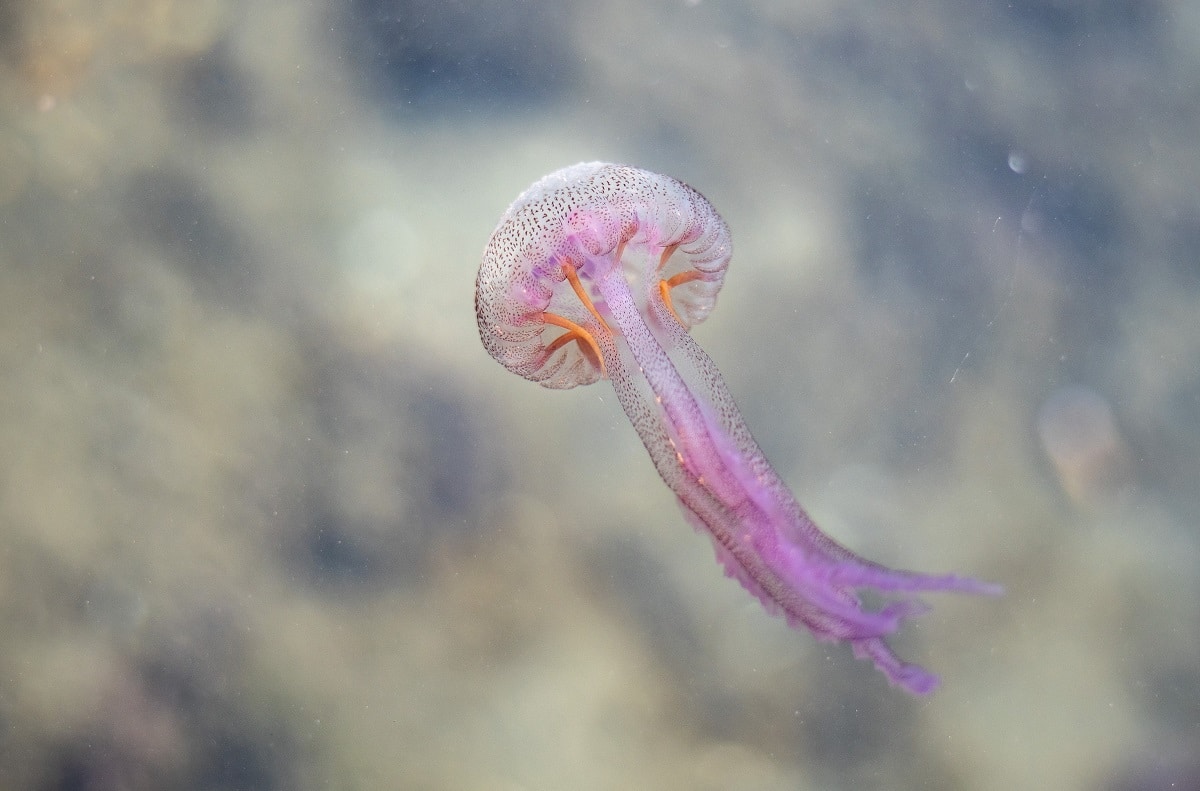Went snorkeling in the Mediterranean and got stung by a jellyfish? There’s a good chance the culprit was Pelagia noctiluca, also known as the mauve stinger. Though pretty to look at, these pinkish-purple polka-dotted jellies unfortunately pack a pretty powerful (though rarely dangerous) sting.
Keep reading to find out everything you need to know about the mauve stinger, how to recognize it, where it can be found and other facts.
| Name (common, scientific) | Mauve stinger, purple stinger, Pelagia noctiluca |
| Family | Pelagiidae |
| Spread | Mostly North Atlantic and Mediterranean |
| Habitat | Open ocean, sometimes shores |
Mauve stinger appearance
It’s not difficult to see how the mauve stinger got its name: this jellyfish has a partially translucent to yellowish body dotted with pale pink to purple coloration. It’s not particularly large, with a maximum bell size of around 12 cm (4.5″).
Pelagia noctiluca has four oral arms, which look like thick, patterned tentacles and are used to transport prey to the mouth (or, more correctly, the gastrovascular cavity). It also sports eight tentacles, which it uses to catch prey in the first place.
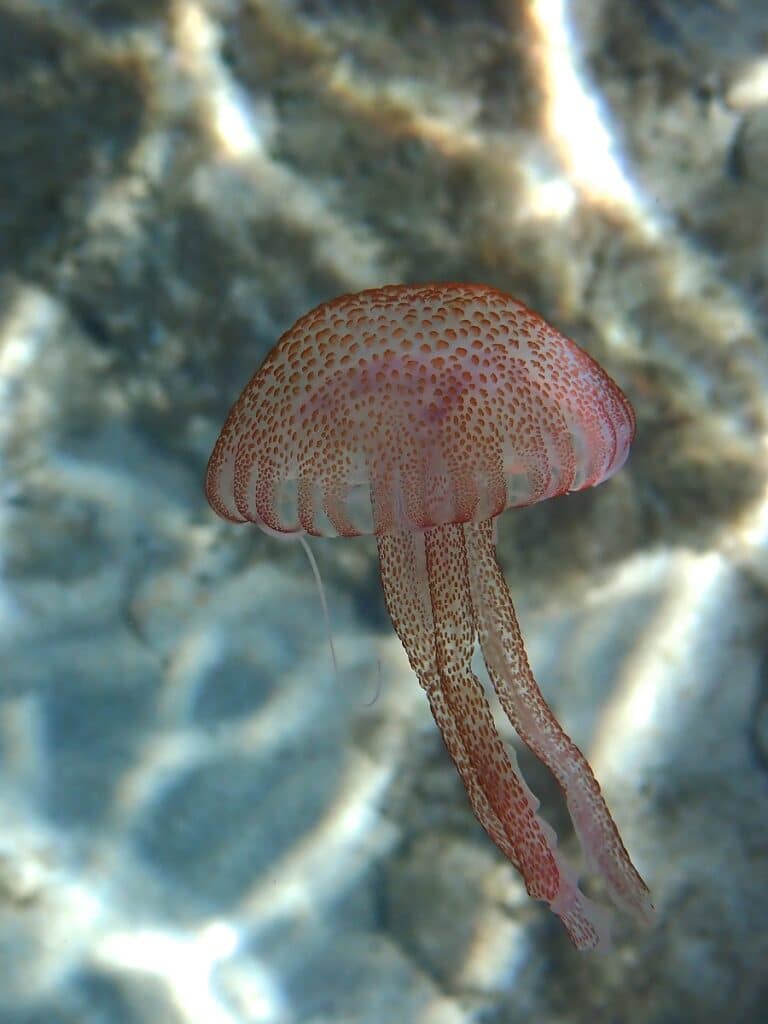
Mauve stinger habitat
Although the mauve stinger is found throughout much of the northern Atlantic, sometimes as far north as Canada, the place it’s most strongly associated with for most folks is the Mediterranean Sea. Huge blooms of these jellies can occur here, and their frequency is actually increasing. Particularly massive amounts popped up in the early ’80s.
Although this is an oceanic species, currents and the wind can blow populations closer to shore. Combine this with mild winters, especially as a result of climate change, and you’ve got jellyfish soup waiting to happen. There can be millions of them in a single bloom, spread over huge patches of seawater.
In some areas in Spain, for example, there can be so many mauve stingers that local tourism and fisheries suffer. Not to mention how Irish salmon farms regularly get hit, with hundreds of thousands of fish left dead at times! Nuisance blooms also happen in the Adriatic, on the Gulf Coast and beyond.
Although they may not be as ubiquitous in other locations as they are in the Mediterranean, mauve stingers are actually pretty widespread. They’re also found in the North Sea and as far north as Canada, as well as in warmer waters much closer to the equator, like the Gulf of Mexico.
Did you know? P. noctiluca can be found at depths of up to 1,400m (4600 ft), although they usually stick to a maximum of around 150m (500 ft). Seasonal changes in their preferred depth may have something to do with their life cycle, as well as with the water temperature.
Planning your next snorkel trip?
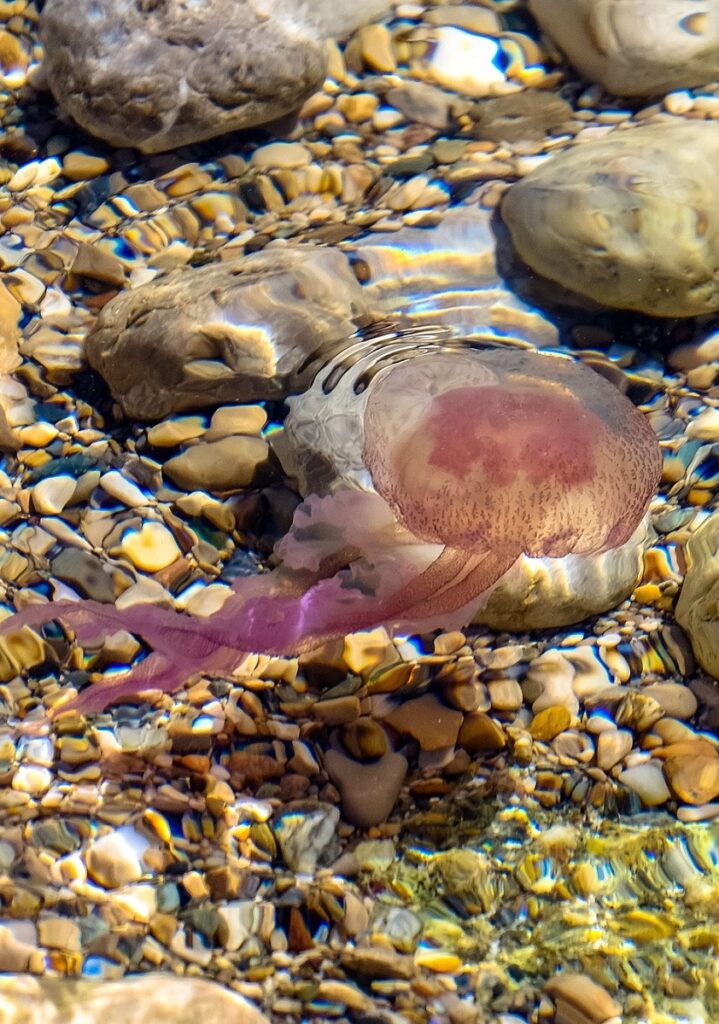
Mauve stinger diet
Like many other jellyfish, Pelagia noctiluca survives off a rather modest diet. It mostly eats plankton, which is a common name for a very wide variety of tiny organisms that float along with the ocean currents.
Examples of types of plankton consumed by this jellyfish include copepods (their favorite food), water fleas, eggs and larvae of crustaceans, fish and molluscs, smaller mauve stingers and even tiny phytoplankton (photosynthesizing plankton types like green algae and cyanobacteria).
The fact that it does prey on fish eggs and larvae means that blooms of this jellyfish can have a negative effect on local fish populations. They apparently have a specific taste for baby anchovy. Additionally, large amounts of mauve stingers can end up consuming so much plankton that other species go hungry, causing ecosystem disruption when a bloom happens.
Interestingly, research has also shown that P. noctiluca will consume Mnemiopsis
leidyi, a comb jelly also referred to as the sea walnut that is invasive in Europe.
Did you know? It’s eat or be eaten! Mauve stingers are a source of food for large fish like tuna and swordfish, as well as for jellyfish-loving loggerhead turtles.
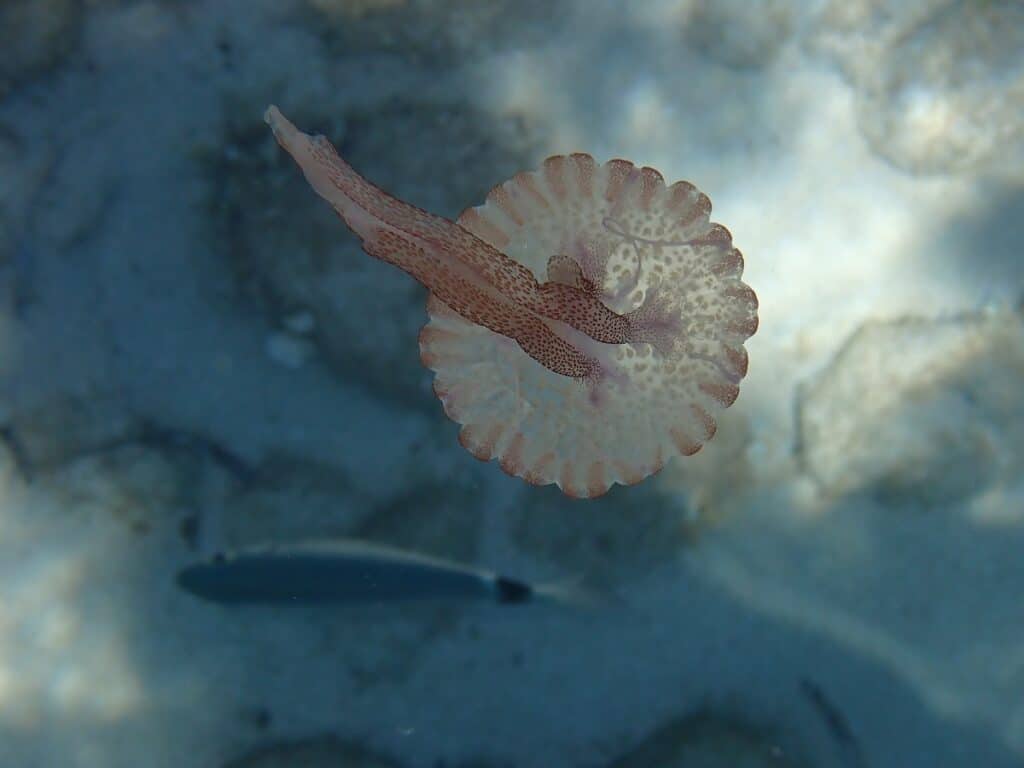
Mauve stinger facts
Sting
In some areas in the Mediterranean, like the Calatonian coast in Spain, mauve stingers are responsible for the majority of jellyfish stings. Although serious issues as a result of being stung by one are rare, it’s still not a nice sensation. Skin irritation and rashes that last for up to two weeks are not uncommon, though infections are rare.
If you happen to be allergic or sensitive, the effects of being stung by a mauve stinger can be significantly more bothersome. The stings may leave scars or skin spots, and they can even begin to cause symptoms again after years due to an immunological response.
A small percentage of beachgoers stung by Pelagia noctiluca also experience symptoms like nausea, vomiting and/or diarrhea. Again, not deadly (there have been no known fatalities), but not really fun either!
Warning: Unlike most other jellyfish, P. noctiluca also has stinging cells (nematocysts) on its bell, not just on the tentacles. Just don’t touch any part of it, even if it’s dead and washed up on the shore.
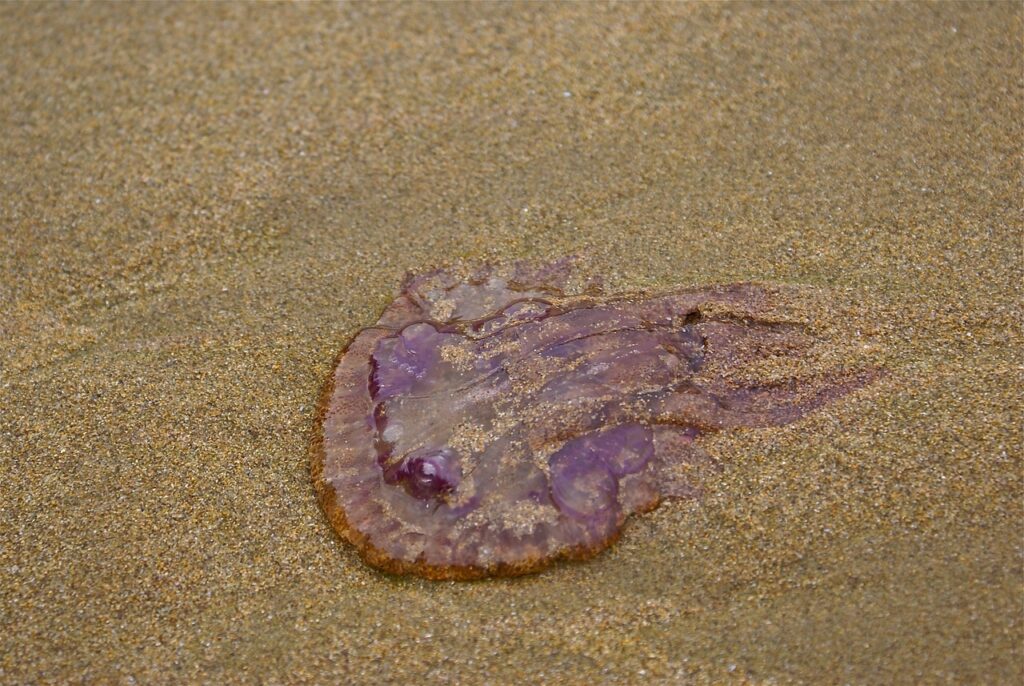
Diurnal vertical migration
As discussed, among other things, the mauve stinger eats zooplankton. Many species of plankton participate in what is called diurnal vertical migration: they move closer to the ocean surface at night and migrate to deeper parts during the day.
As you can imagine, the jellyfish does the same, drifting up and down along with the plankton as the days progress. It can usually be found almost at the surface at night, while during the day, it may stay several hundreds of feet deep. This allows it to follow its prey with maximum efficiency!
Bioluminescence
The Latin ‘noctiluca’ is a combination of the words for “night” and “light”. There’s a reason for that: the mauve stinger is bioluminescent! The edges of its bell light up at night. As we just discussed, it’s usually found at the water surface during the dark, so it can actually be spotted lighting up the water.
It has been known for a long time that this jellyfish glows in the dark. Pliny the Elder, one of Ancient Rome’s most prominent naturalists, actually wrote about the phenomenon in 77 AD, almost 2000 years ago now. However, he didn’t know what actually causes bioluminescence, or what its function is.
Nowadays, we know that bioluminescent jellyfish like this one mostly release their glowing enzymes (called luciferin and luciferase) when disturbed. As such, the ability is thought to help protect them by confusing predators.
Once the luciferin and luciferase hit the water, they light up and leave a glowing trail. Quite a sight, and it’s actually of increasing interest to science as well.
Life cycle
As explained in the post on the fried egg jellyfish (a rather more harmless and funny-looking Mediterranean jelly), these invertebrates have pretty complicated life cycles. They start out as a tiny planula, hatched from an even tinier egg, which will settle on the seafloor and grow into a polyp.
The polyp eventually starts reproducing itself, with each offset forming a free-swimming ephyra. Only when the ephyra metamorphoses, the jellyfish that we’re familiar with finally appears.
The mauve stinger is a little different in this respect. It completely skips the polyp stage, turning directly from a planula into an ephyra. Reproduction tends to take place in fall and possibly spring, during which P. noctiluca blooms at the surface are common while they pair up and release their eggs.
Did you know? The average Pelagia noctiluca jellyfish only lives for around nine to twelve months. Scientists think their life cycle is annual.
If you have any more questions about the mauve stinger jellyfish or would like to share your own experiences with Pelagia noctiluca, don’t hesitate to leave a comment below!

